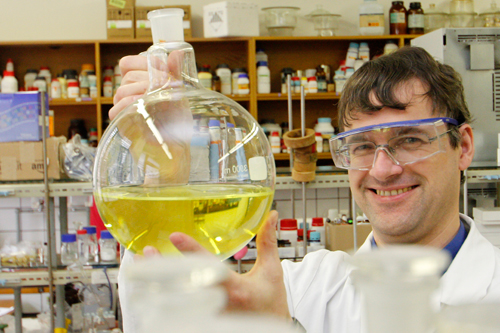Der russische Chemiker Dmitri Mendelejew hat seinerzeit, 1869, einen systematischen Zusammenhang zwischen Atommasse und chemischen Eigenschaften der Elemente entdeckt und damit das Periodensystem geschaffen. Insgesamt umfasst das Periodensystem 118 Elemente - von Wasserstoff (1) bis Oganesson (118). Die Elemente sind nach der Anzahl ihrer positiven Teilchen (Protonen) im Atomkern durchnummeriert. Sie sind in Gruppen (senkrechte Spalten) und Perioden (waagrechte Zeilen) angeordnet. Die Mitglieder einer Gruppe haben alle gleich viele negativ geladene Teilchen (Elektronen) in ihrer äußersten Elektronenschale und somit ähnliche chemische Eigenschaften. Die Elemente einer Periode haben alle gleich viele Elektronenschalen. Uni-Graz-Chemiker Wolfgang Kroutil erklärt
„Bis es zu der für uns heute vertrauten bekannten zeilen- und spaltenweisen Anordnung der Elemente im Periodensystem kam, dauerte es mindestens 80 Jahre und zahlreiche Diskussion vieler Chemiker. Angefangen hat die Diskussion mit einer einfachen Liste von 33 vermutlichen Substanzen durch Antoine Lavoisier wobei im Jahre 1789 er auch noch Licht und Wärme als Elemente klassifizierte. Die Genialität des veröffentlichten Periodensystems vor 150 Jahren war, dass in dieser Darstellung Positionen frei gelassen wurden für Elemente die noch nicht entdeckt worden waren und deren Eigenschaften man aufgrund der Position voraussagen konnte. Waren vor 150 Jahren noch alle beschriebenen Elemente (ca. 50) natürlich auf der Erde nachgewiesen, so werden heute in etwa 90 der heute bekannten Elemente als natürlich vorkommend eingestuft. Von diesen haben auch zwei Österreicher einige entdeckt. So hat der Chemiker und Mineralogen Franz Joseph Müller von Reichenstein das Element Tellur (1782) entdeckt, und Carl Auer von Welsbach die chemischen Elemente Neodym (1885), Praseodym (1885) und Lutetium (1907). Circa 30 Elemente werden für den Zusammenbau eines Smartphones benötigt. Da die natürliche Häufigkeit einiger davon sehr gering ist, wird ein Engpass erwartet, was Forschung für Alternativen antreibt.“
Zum Artikel von der APA - Austrian Presse Agentur.

